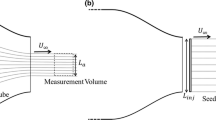Abstract
The drag of a sphere at highRe can be reduced to more than half its value by passive ventilation from the stagnation region to the base. Simultaneously, the flow field around the base is stabilized and made symmetric, leading to reduction of unsteady aerodynamic forces. At highRe, the vent flow breaks through the dead water region associated with the near wake and aerodynamically streamlines the base. The streamlining is done by virtue of a base-vortex-ring beyond the point of turbulent boundary layer separation. A mean flow model for the flow around the vented sphere is proposed.
Smoke flow visualized on a laser light screen placed at two diameters behind the base of the sphere shows the effectiveness of the method in suppressing the flow oscillations.
The drag reduction achieved is very sensitive to the quality of the external surface and relatively insensitive to disturbances in the internal flow. Surface roughness or boundary layer tripping wire on the external flow can completely offset the benefit obtained.
Similar content being viewed by others
References
Aachenbach, E. 1972: Experiments on the flow past spheres at very high Reynolds numbers. J. Fluid Mech. 62, 209–221
Bearman, P. W. 1967: The effect of base bleed on the flow behind a two-dimensional model with a blunt trailing edge. The Aeronautical Quarterly, 207–224
Clift, R.; Grace, J. R.; Weber, M. E. 1978: Bubbles, drops and particles. London: Academic Press
Dallmann, U.; Schewe, G. 1987: On topological changes of separating flow structures at transition Reynolds numbers. AIAA 87–1266
Gad-El-Hak, M.; Bushnell, D. M. 1991: Separation control: review. J. Fluids Eng. 5–29
Lin, J. C. et al. 1990: Comparative study of control techniques for two-dimensional low-speed turbulent boundary layer separation. IUTAM Symposium on separated flows and jets, Novosibirsk, USSR
Mair. W. A. 1978: Drag reduction techniques for axisymmetric bluff-bodies. Aerodynamic drag mechanisms of bluffbodies and road vehicles, pp 161–187. New York: Plenum Press.
Meier, G. E. A.; Suryanarayana G. K.; Pauer H. 1990: Widerstandsverminderung durch Ventilation, pp 311–315. DGLR Bericht 90-06
Raithby, G. D.; Eckert, E. R. G. 1968: The effect of support position and turbulence intensity on the flow near the surface of a sphere, Wärme und Stoffübertragung, Bd l, Heft 2, 87–94
Roshko, A. 1954: On the drag and shedding frequency of two-dimensional bluff-bodies. NACA TN 3169
Suryanarayana, G. K.; Pauer, H.; Meier, G. E. A. 1992: Passive control of the wake of a sphere by Ventilation. IUTAM Symposium on Bluff-Body Wakes, Dynamics and Instabilities, Goettingen, Germany, Springer-Verlag, Berlin, 93–96
Taneda, S. 1978: Visual observations of the flow past a sphere at Reynolds numbers between 104 and 106. J. Fluid Mech 85, 178–192
Wong, H. Y. 1985: Wake Flow Stabilization by the Action of Base Bleed. Journal of Fluids Eng. Transactions of the ASME, Vol. 107, 378–384
Wood, C. J. 1964: The effect of base bleed on periodic wake. J. Royal Aeronautical Society, Vol. 68, 477–482
Author information
Authors and Affiliations
Rights and permissions
About this article
Cite this article
Suryanarayana, G.K., Pauer, H. & Meier, G.E.A. Bluff-body drag reduction by passive ventilation. Experiments in Fluids 16, 73–81 (1993). https://doi.org/10.1007/BF00944909
Received:
Accepted:
Issue Date:
DOI: https://doi.org/10.1007/BF00944909




